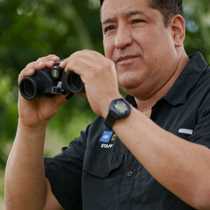Pacaya River
A beautiful sunshine in the morning welcomed us to the Pacaya River. Our home this week, Delfin II, was tied just at the confluence of the Pacaya River with Ucayali River. After just few seconds on the skiffs we had a great sighting, the first one of the many that we had during the morning. A large amount of Jabirus (Jabiru mycteria), Wood storks (Mycteria americana), different species of herons and some vultures were observed just at the mouth of the Pacaya River. As the high levels of the flooded rivers that we had until just few weeks ago are quickly coming down it is possible to observe large groups of these birds capturing fish along the riverbanks. Jabirus are huge, around 55 inches; wood storks followed them in size (around 40 inches). Their typical shape is unmistakable, long legs and necks. In Jabirus the bare lower neck is reddish and in wood storks is plain black.
After this sighting we continued travelling to a paradisiacal lagoon where we observed the beautiful Amazon giant water lilies (Victoria regia). Today there were hundreds of herons flying everywhere. In the company of these birds we tied the three skiffs and had breakfast in the middle of the rain forest. How many people can say that they have had breakfast like that? Served by white-gloved Naturalists we had our first meal of the day in the most remote and unexpected place.
Among the many bird species that were seen along the lagoon, the Black capped Donacobius was a favorite. Today we had a great sighting of hundreds of martins perching on a single tree. With amusement we observed how the birds were jostling trying to get a place to perch. Suddenly all of them obscured the sky for they decided to fly around for a while. After a couple of minutes they came back to the same tree. Gray-breasted Martins (Progne chalybea) and Southern Martins (Progne elegans) formed this enormous flock. The latter species is an austral migrant seen mainly in the area of Loreto (name of the Peruvian Department where the Reserve is located) where they winter.
Once aboard and after a deserved rest, for it was extremely hot out there, I had the joy of giving one of favorite talks ever, bats. I became a specialist in this unusual field after years of research and study of these marvelous creatures.
After lunch, we went back to the Pacaya River. On this occasion we went as far as we could with the objective of reaching an idyllical lagoon. In “Yanayacu lagoon” several guests had the thrill of swimming these calm waters with Pink river dolphins that were seen and heard nearby. On our way back to the ship we finally spotted the largest of the Neotropical monkey species, the Red Howler Monkeys (Allouta seniculus). A constant rain accompanied us in the way back letting us know how lucky we were on previous days for we did not have rain at all during our outings.
As the night approached, our Naturalists aided our drivers with spotlights in their hands as we navigated the Pacaya River in route to our home. This day was one of my favorites, for we had the chance to explore in detail one of the most remote, vast and pristine areas of the Pacaya-Samiria Reserve in the upper Amazon of Peru.




